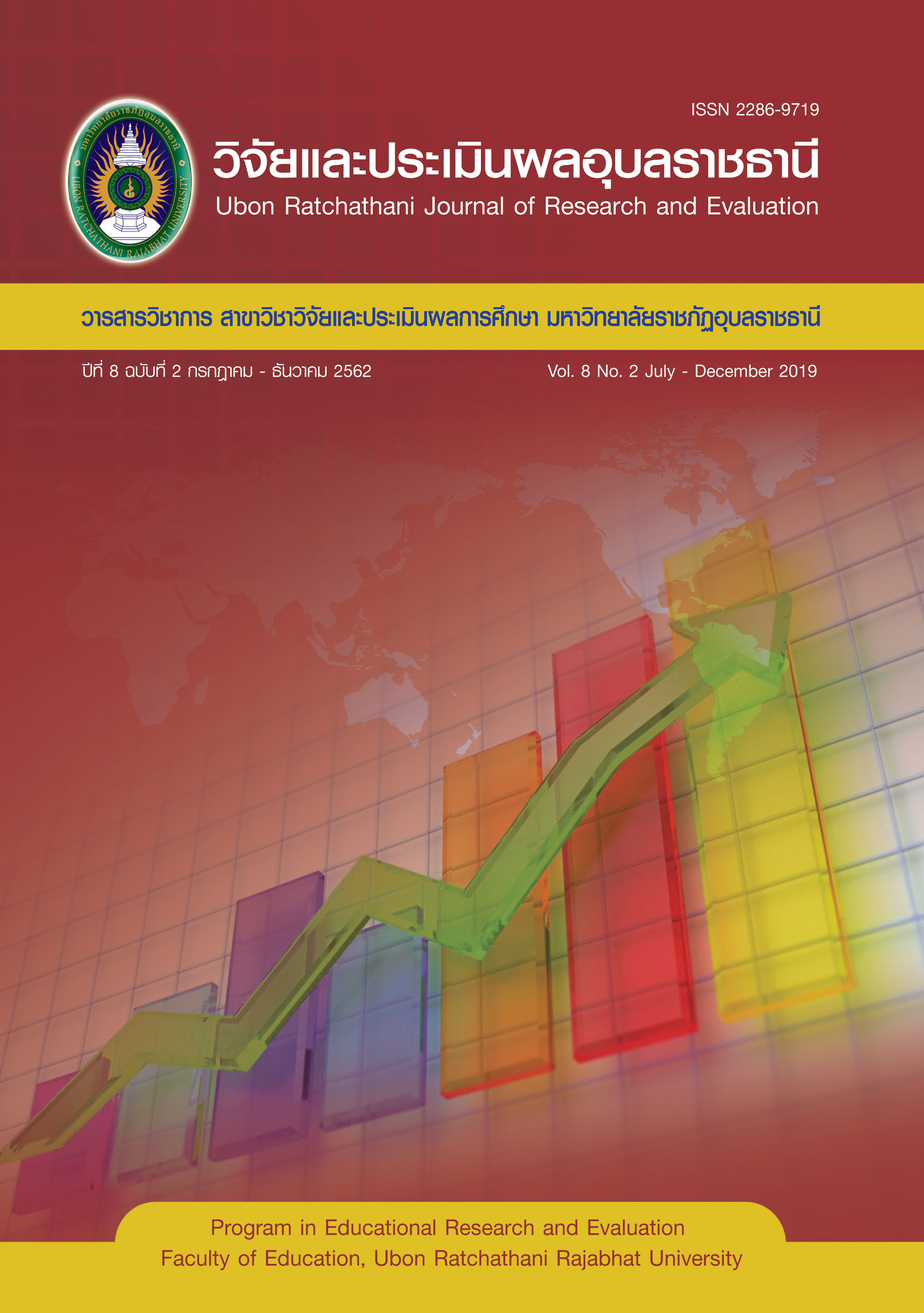การพัฒนาแบบฝึกทักษะการเขียนสะกดคำโดยใช้รูปแบบการสอนภาษาไทยแนวสมดุลภาษา สำหรับนักเรียนชั้นประถมศึกษาปีที่ 1
คำสำคัญ:
การสอนภาษาไทยแนวสมดุลภาษา, ความสามารถในการเขียนสะกดคำบทคัดย่อ
การวิจัยครั้งนี้มีวัตถุประสงค์ 1) เพื่อพัฒนาแบบฝึกทักษะการเขียนสะกดคำโดยใช้รูปแบบการสอนภาษาไทยแนวสมดุลภาษาสำหรับนักเรียนชั้นประถมศึกษาปีที่ 1 ให้มีประสิทธิภาพตามเกณฑ์ 80/80 2) เพื่อเปรียบเทียบความสามารถในการเขียนสะกดคำก่อนและหลังการใช้แบบฝึกทักษะการเขียนสะกดคำโดยใช้รูปแบบการสอนภาษาไทยแนวสมดุลภาษาและ 3)เพื่อศึกษาความพึงพอใจของนักเรียนที่มีต่อการเรียนด้วยแบบฝึกทักษะการเขียนสะกดคำโดยใช้รูปแบบการสอนภาษาไทยแนวสมดุลภาษา ตัวอย่างในการวิจัยคือ นักเรียนชั้นประถมศึกษาปีที่ 1/2 โรงเรียนสาธิตมหาวิทยาลัยราชภัฏอุบลราชธานี จำนวน 30 คน ได้มาด้วยการสุ่มแบบกลุ่ม เครื่องมือที่ใช้คือ แบบฝึกทักษะการเขียนสะกด แผนการจัดการเรียนรู้โดยใช้รูปแบบการสอนภาษาไทยแนวสมดุลภาษา จำนวน 6 แบบฝึก และแบบวัดความสามารถทางการเขียนสะกดคำแบบปรนัย ชนิด 3 ตัวเลือก จำนวน 30 ข้อ ซึ่งมีค่าความยากระหว่าง 0.46-0.64 ค่าอำนาจจำแนกระหว่าง 0.22-0.41 ค่าความเชื่อมั่นของแบบทดสอบทั้งฉบับเท่ากับ 0.92 แบบสอบถามความพึงพอใจของนักเรียนที่มีต่อการเรียนด้วยแบบฝึกทักษะการเขียนสะกดคำโดยใช้รูปแบบการสอนภาษาไทย
แนวสมดุลภาษา สถิติที่ใช้ได้แก่ ค่าเฉลี่ย ค่าร้อยละ ส่วนเบี่ยงเบนมาตรฐาน และการทดสอบที
ผลการวิจัยพบว่า
- แบบฝึกทักษะการเขียนสะกดคำโดยใช้รูปแบบการสอนภาษาไทยแนวสมดุลภาษา สำหรับนักเรียน
ชั้นประถมศึกษาปีที่ 1 ที่ผู้วิจัยพัฒนาขึ้นมีประสิทธิภาพเท่ากับ 85.57/86.11 - ความสามารถในการเขียนสะกดคำหลังเรียนของนักเรียน โดยใช้แบบฝึกทักษะการเขียนสะกดคำ
โดยใช้รูปแบบการสอนภาษาไทยแนวสมดุลภาษาสูงกว่าก่อนเรียนอย่างมีนัยสำคัญทางสถิติที่ระดับ .05 - ความพึงพอใจของนักเรียนที่มีต่อการเรียนด้วยแบบฝึกทักษะการเขียนสะกดคำ โดยใช้รูปแบบการสอนภาษาไทยแนวสมดุลภาษาอยู่ในระดับมาก
เอกสารอ้างอิง
Meesomsarn, K. (2011). Development of a language instructional model integrating balanced literacy approach and cooperative learning to enhance language ability of first grade students (Doctoral of education dissertation, program in Curriculum and Instructional). Chulalongkorn University, Bangkok. [in Thai].
กิติยาพร เนื้ออ่อน. (2552). การพัฒนาแบบฝึกทักษะการเขียนสะกดคำ กลุ่มสาระการเรียนรู้ภาษาไทย ชั้นประถมศึกษาปีที่ 5 (วิทยานิพนธครุศาสตรมหาบัณฑิต, สาขาวิชาพัฒนาหลักสูตรและการเรียนการสอน). มหาวิทยาลัยราชภัฏอุบลราชธานี, อุบลราชธานี.
Nue-orn, K. (2009). The development of word spelling drills in the Thai Language Strand for Prathom Suksa 5 students (Master of education thesis, program in Curriculum and Instructional Development). Ubon Ratchathani Rajabhat University, Ubon Ratchathani.
[in Thai].
ขจรศักดิ์ ประทุมพันธ์. (2554). การพัฒนาแบบฝึกทักษะการเขียนสะกดคำ กลุ่มสาระการเรียนรู้ภาษาไทย ชั้นประถมศึกษาปีที่ 1 (วิทยานิพนธครุศาสตรมหาบัณฑิต, สาขาวิชาพัฒนาหลักสูตรและการเรียนการสอน). มหาวิทยาลัยราชภัฏอุบลราชธานี, อุบลราชธานี.
Pratumpan, K. (2011). The development of writing drills on word spelling in the Thai Language Prathom suksa I (Master of education thesis, program in Curriculum and Instructional Development), Ubon Ratchathani Rajabhat University, Ubon Ratchathani. [in Thai].
ขนิษฐา พละพันธ์. (2555). การพัฒนาแบบฝึกทักษะการเขียนสะกดคำ กลุมสาระการเรียนรูภาษาไทยสําหรับ นักเรียนชั้นประถมศึกษาปที่ 2 (วิทยานิพนธครุศาสตรมหาบัณฑิต, สาขาวิชาพัฒนาหลักสูตรและการเรียนการสอน). มหาวิทยาลัยราชภัฏอุบลราชธานี, อุบลราชธานี.
Palapun, K. (2012). The development of word spelling drills on the Thai Language Strand for Prathom Suksa II Pupils (Master of education thesis, program in Curriculum and Instructional Development). Ubon Ratchathani Rajabhat University, Ubon Ratchathani. [in Thai].
ผดุง อารยะวิญญู. (2544). เด็กที่มีปัญหาในการเรียนรู้ (พิมพ์ครั้งที่ 2). กรุงเทพฯ: โรงพิมพ์แว่นแก้ว.
Arayawinyu, P. (2001). Children with learning disabilities (2nd ed). Bangkok: Wankaew Publishing House. [in Thai].
เมรี ง้าวทอง, (2555). การพัฒนาแบบฝึกทักษะการเขียนคำที่มีตัวสะกดไม่ตรงมาตรา สำหรับนักเรียนชั้นประถมศึกษาปีที่ 2 (วิทยานิพนธครุศาสตรมหาบัณฑิต, สาขาวิชาพัฒนาหลักสูตรและการเรียนการสอน). มหาวิทยาลัยราชภัฏอุบลราชธานี, อุบลราชธานี.
Ngawthong, M. (2012). The development of drills enhancing spelling the words with odd final sounds for Prathom Suksa II pupils (Master of education thesis, program in Curriculum and Instructional Development). Ubon Ratchathani Rajabhat University, Ubon Ratchathani. [in Thai].
ยุวดี โสภาพร. (2555). ผลการจัดกิจกรรมการเรียนรู้ตามแนวสมดุลภาษาเสริมด้วยแผนผังความคิดที่มีต่อความสามารถในการเขียนสะกดคำและผลสัมฤทธิ์ทางการเรียนวิชาภาษาไทย ของนักเรียนชั้นประถมศึกษาปีที่ 1 (วิทยานิพนธ์ครุศาสตรมหาบัณฑิต, สาขาหลักสูตรและการสอน). มหาวิทยาลัยราชภัฏอุดรธานี, อุดรธานี.
Sopaphon, Y. (2012). The effect of learning activities based on language balance, supplemented by conceptual charts on spelling learning ability and Thai language learning achievement of grade 1 students (Master of education thesis, program in Curriculum and Instruction). Udon Thani Rajabhat University, Udon Thani. [in Thai].
รัชฎาภรณ์ ศุภสร. (2553). การพัฒนาแบบฝึกทักษะการเขียนสะกดคำ กลุ่มสาระการเรียนรู้ภาษาไทย ชั้นประถมศึกษาปีที่ 2 (วิทยานิพนธครุศาสตรมหาบัณฑิต, สาขาวิชาพัฒนาหลักสูตรและการเรียนการสอน). มหาวิทยาลัยราชภัฏอุบลราชธานี, อุบลราชธานี.
Suphasorn, R. (2008). The development of writing drills on word spelling in the Thai Language Prathom suksa II (Master of education thesis, program in Curriculum and Instructional Development). Ubon Ratchathani Rajabhat University, Ubon Ratchathani. [in Thai].
วรรณี โสมประยูร. (2553). เทคนิคการสอนภาษาไทย. กรุงเทพฯ: ดอกหญ้าวิชาการ.
Somprayoon, W. (2010). Thai Language teaching techniques. Bangkok: Dokya Academic.
วรินทร โพนน้อย. (2555). นวัตกรรมการจัดการเรียนรู้ภาษาไทยแบบสมดุลภาษาสำหรับนักเรียนชั้นประถมศึกษา. (ดุษฎีนิพนธ์การศึกษาดุษฎีบัณฑิต, สาขาวิจัยและพัฒนาหลักสูตร). มหาวิทยาลัยศรีนครินทรวิโรฒ, กรุงเทพฯ.
Phonnoi, W. (2012). The innovation of learning management model in Thai Language for elementary by using balanced literacy approach (Doctoral of education dissertation, program in Curriculum Research and Development). Srinakharinwirot University, Bangkok. [in Thai]
กระทรวงศึกษาธิการ. (2552). หลักสูตรแกนกลางการศึกษาขั้นพื้นฐาน พุทธศักราช 2551. กรุงเทพฯ: โรงพิมพ์ชุมนุมสหกรณ์การเกษตรแห่งประเทศไทย.
Ministry of Education. (2009). The basic education core curriculum B.E. 2551. Bangkok: Agriculture Cooperative of Thailand Publishing House Limited. [in Thai].
อรุณ ทองประเสริฐ. (2555). การพัฒนาชุดฝึกทักษะการเขียนสะกดคำ กลุ่มสาระการเรียนรู้ภาษาไทย ชั้นประถมศึกษาปีที่ 2 (วิทยานิพนธครุศาสตรมหาบัณฑิต, สาขาวิชาพัฒนาหลักสูตรและการเรียนการสอน). มหาวิทยาลัยราชภัฏอุบลราชธานี, อุบลราชธานี.
Thongprasert, A. (2012). The development of writing skill packages on the Thai Language Strand Prathom Suksa II (Master of education thesis, program in Curriculum and Instructional Development). Ubon Ratchathani Rajabhat University, Ubon Ratchathani. [in Thai].
อารี สัณหฉวี. (2550). การสอนภาษาไทยแนวสมดุลภาษา. กรุงเทพฯ: สมาคมเพื่อการศึกษาเด็ก.
Sunhachawee, A. (2007). Thai Language Balanced Literacy. Bangkok: Association for Child Education. [in Thai].
Ivey, G., Baumannn, J.F., & Jarrard, D. (2000). Exploring literacy balance: Iterations in a second-grade and sixth-grade classroom. Reading Research and Instruction, 39(4), 291-309.
Lawery, Eleanor Blodwynlanc. (1987). The effects of four drills and practices times unit on the decoding performances of students with specific learning disabilities. Dissertation Abstracts International. 39, (7), 817-A.
ดาวน์โหลด
เผยแพร่แล้ว
รูปแบบการอ้างอิง
ฉบับ
ประเภทบทความ
สัญญาอนุญาต
1. บทความที่ตีพิมพ์ในวารสารนี้ได้มีการตรวจสอบการลอกเลียนงานวรรณกรรมแล้ว ไม่เกินร้อยละ 25
2. บทความที่ตีพิมพ์ในวารสารนี้เป็นข้อคิดเห็น ข้อค้นพบของผู้เขียนบทความ โดยผู้เขียนบทความต้องเป็นผู้รับผิดชอบต่อผลทางกฎหมายใด ๆ ที่อาจเกิดขึ้นจากบทความนั้น ๆ
3. บทความ ข้อมูล เนื้อหา รูปภาพ ฯลฯ ที่ได้รับการตีพิมพ์ในวารสารวิจัยและประเมินผลอุบลราชธานี ถือเป็นลิขสิทธิ์ของวารสารวิจัยและประเมินผลอุบลราชธานี หากบุคคลหรือหน่วยงานใดต้องการนำทั้งหมดไปเผยแพร่ต่อหรือเพื่อกระทำการใดๆ จะต้องได้รับอนุญาตเป็นลายลักษณ์อักษรจากวารสารวิจัยและประเมินผลอุบลราชธานีก่อนเท่านั้น และจะต้องมีการอ้างอิงวารสารวิจัยและประเมินผลอุบลราชธานี ฉบับนั้น ๆ ด้วย






